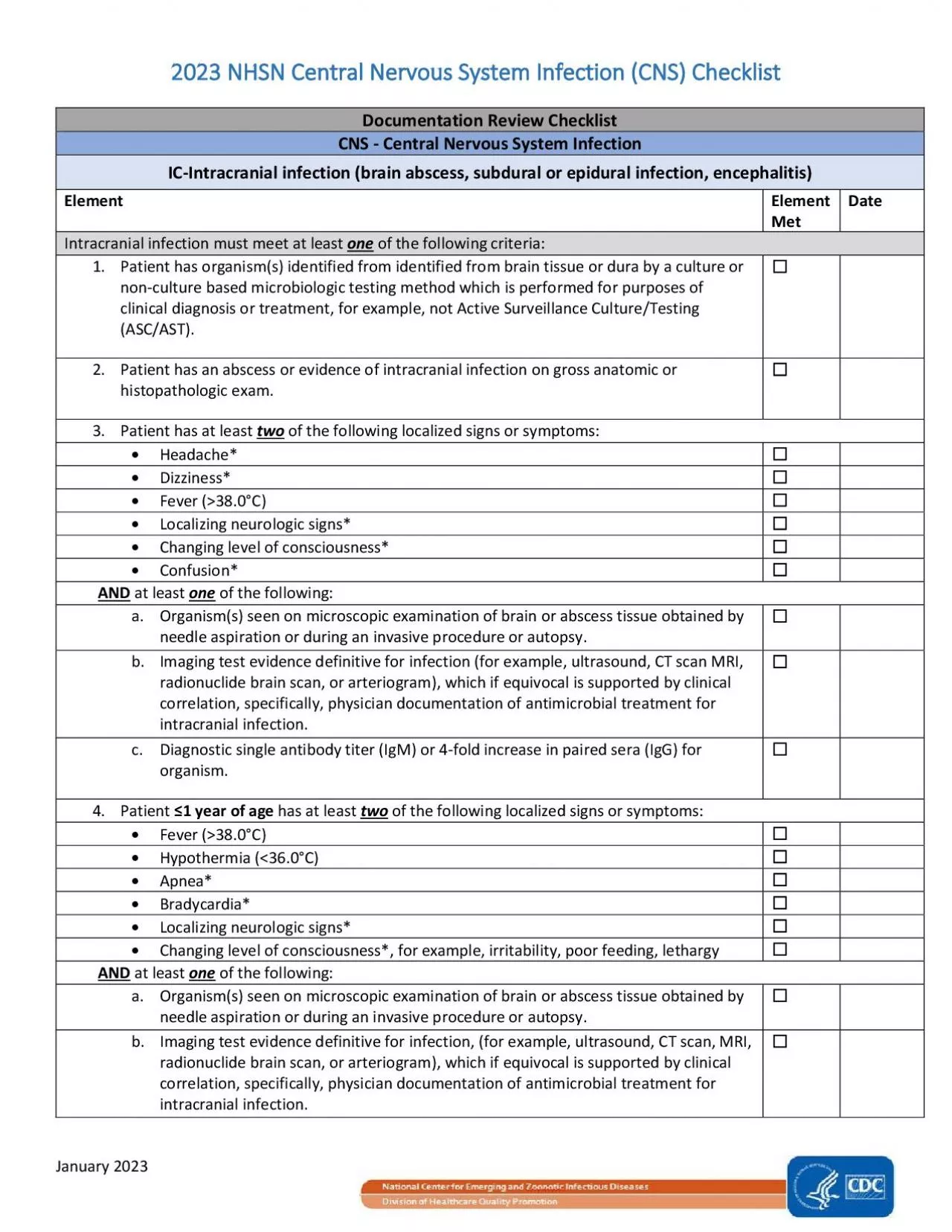

January 2022 Documentation Review Checklist CNS Central Nervous System Infection Intracranial infection brain abscess subdural or epidural infection encephalitis ElementElementMet Intracranial ID: 940673
Download Pdf The PPT/PDF document "2 NHSN Central Nervous SystemInfectionCN..." is the property of its rightful owner. Permission is granted to download and print the materials on this web site for personal, non-commercial use only, and to display it on your personal computer provided you do not modify the materials and that you retain all copyright notices contained in the materials. By downloading content from our website, you accept the terms of this agreement.
January 2022 2 NHSN Central Nervous SystemInfection(CNS)Checklist Documentation Review Checklist CNS - Central Nervous System Infection Intracranial infection (brain abscess, subdural or epidural infection, encephalitis) ElementElementMet Intracranial infection must meet at least of the following criteria: Patient has organism(s) identified from identified from brain tissue or dura by a culture or nonculture based microbiologic testing method which is performed for purposes of clinical diagnosis ortreatment, for example, not Active Surveillance Culture/Testing (ASC/AST). Patient has at least twoof the following localized signs or symptoms: Headache* Dizziness* ever (�38.0°C) ocalizing neurologic signs* hanging level of consciousness* Confusion* ANDat least of the following: a. Imaging test evidence suggestive of infection (for example, ultrasound, CT scan MRI, radionuclide brain scan, or arteriogram), which if equivocal is supported by clinical correlation, specifically, physician documentation of antimicrobial treatment for intracranial infection. c.iagnostic single antibody titer (IgM) or 4fold increase in paired sera (IgG) for organism Patient ≤1 year of agehas at least twoof the following localized signs or symptoms: Fever (�38.0°C) Hypothermia (36.0°C) pnea* Localizing neurologic signs* Changing level of consciousness*, for example, irritability, poor feeding, lethargy ANDat least of the following: a. O maging test evidence suggestive of infection, (for example, ultrasound, CT scan, MRI, radionuclide brain scan, or arteriogram), which if equivocal is supported by clinical co
rrelation, specifically, physician documentation of antimicrobial treatment for intracranial infection. January 2022 c.iagnostic single antibody titer (IgM) or 4fold increase in paired sera (IgG) for organism. *With no other recognized cause documented by physician Reporting instructions:Report as MEN if meningitis (MEN) and encephalitis (IC) are present together.Report as IC if meningitis (MEN) and a brain abscess (IC) are present together after operation.Report as SA if meningitis (MEN) and spinal abscess/infection (SA) are present together. January 2022 CNS - Central Nervous System Infection MENMeningitis or ventriculitis ElementElement MetDate Meningitis or ventriculitis must meet at least of the following criteria: Patient has organism(s) identified from cerebrospinal fluid (CSF) by a culture or nonculture based microbiologic testing method, which is performed for purposes of clinical diagnosis or treatment, for example, not Active Surveillance Culture/Testing (ASC/AST). Patient has at least twoof the following: i.Fever (�38.0°C)Headache(Note: Elements of “i” alone may not be used to meet the two required elements) ii.Meningeal sign(s)* iii.Cranial nerve sign(s)* ANDat least of the following: Increased white cells, elevated protein, and decreased glucose in CSF (per reporting laboratory’s reference range). Organism(s) seen on Gram stain of CSF. c.Organism(s) identified from blood by a culture or nonculture based microbiologic testing method, which is performed for purposes of clinical diagnosis or treatment, for example, not Active Surveillance Culture/Testing (A
SC/AST). Diagnostic single antibody titer (IgM) or 4fold increase inpaired sera (IgG) for organism. Patient ≤1 year of agehas at least twoof the following: i.Fever (�38.0°C)Hypothermia (36.0°C)Apnea*Bradycardia*Irritability*(Note: Elements of “i” alone may not be used to meet the required two elements). ii.Meningeal signs* iii.Cranial nerve signs* ANDat least of the following: ncreased white cells, elevated protein, and decreased glucose in CSF (per reporting laboratory’s reference range). rganism(s) seen on Gram stain of CSF. c.Organism(s) identified from blood by a culture or nonculture based microbiologic testing method, which is performed for purposes of clinical diagnosis or treatment, for example, not Active Surveillance Culture/Testing (ASC/AST). Diagnostic single antibody titer (IgM) or 4fold increase in paired sera (IgG) for organism. *With no other recognized causedocumented by physician Reporting instructions:Report CSF shunt infection as SSIMEN if it occurs within 90 days of placement; if later or after manipulation/access, it is considered CNSMEN but is not reportable as an SSI. Report as MEN if meningitis (MEN) and encephalitis (IC) are present together.Report as IC if meningitis (MEN) and a brain abscess (IC) are present together after operati. Report as SA if meningitis (MEN) and spinal abscess/infection (SA) are present together. January 2022 CNS - Central Nervous System Infection Spinal abscess/infection (spinal abscess, spinal subdural or epidural infection) ElementElementMetDate Spinal abscess/infection must meet at leastof the following criteria
: Patient has organism(s) identified from abscess or from purulent material found in the spinal epidural or subdural space by a culture or nonculture based microbiologic testing methodwhich is performed for purposes of clinical diagnosis or treatment, for example, not Active Surveillance Culture/Testing (ASC/AST). Patient has an abscess or other evidence of spinal infectionon gross anatomic or histopathologic exam. Patient has at least of the following localized signs or symptoms: Fever (�38.0°C) ack pain* or tenderness* Radiculitis* araparesis* araplegia* ANDat leastof the following: rganism(s) identified from blood by a culture or nonculture based microbiologic testing method, which is performed for purposes of clinical diagnosis or treatment, for example, not Active Surveillance Culture/Testing (ASC/AST) ANDmaging test evidence suggestive of spinal abscess/infection (for example, myelography, ultrasound, CT scan, MRI, or other scans [gallium, technetium, etc.]), which if equivocal is supported by clinical correlation, specifically, physician documentation of antimicrobial treatment for spinal abscess/infection maging test evidence suggestive of a spinal abscess/infection(for example, myelography, ultrasound, CT scan, MRI, or other scans [gallium, technetium, etc.]), which if equivocal is supported by clinical correlation, specifically, physician documentation of antimicrobial treatment for spinal abscess/infection *With no other recognized causedocumented by physician Reporting instruction: Report as SA if meningitis (MEN) and spinal abscess/infection (SA) are present together after operation